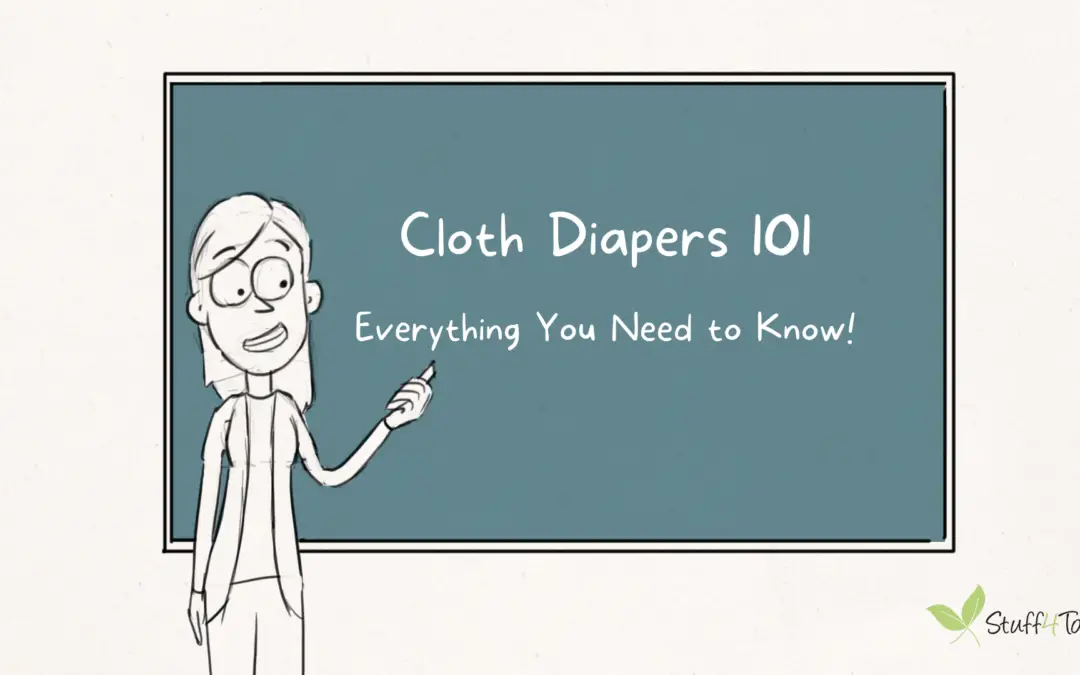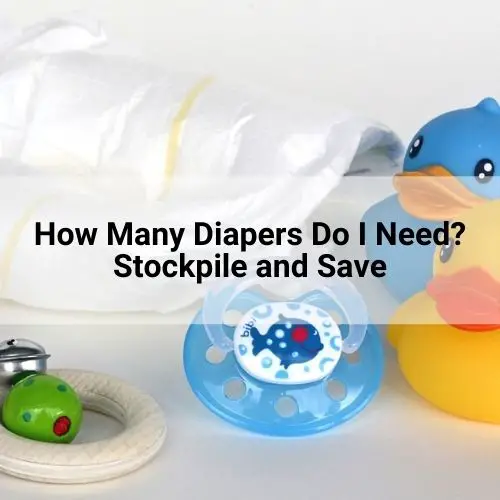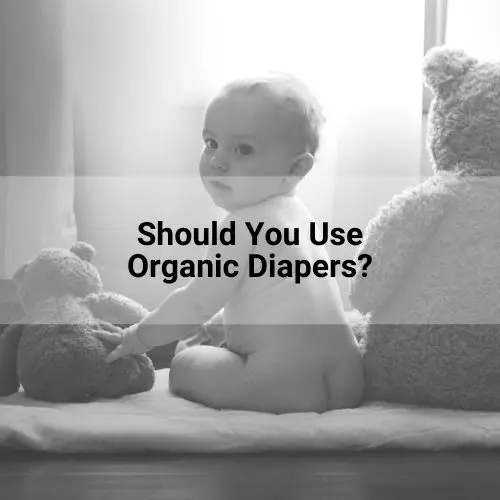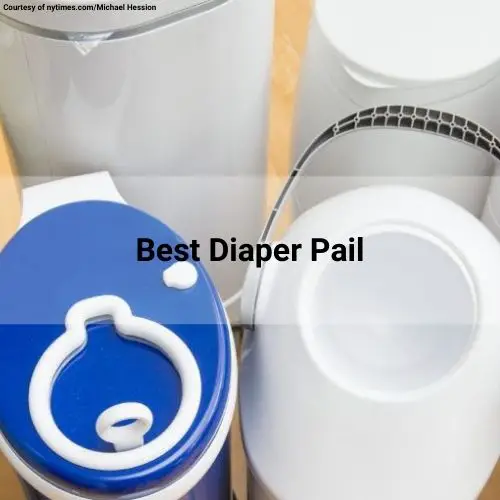Most of us are aware of the benefits that come with changing to cloth diapers, both with reducing the amount of waste we produce, and it being a much more affordable option over time, but many parents are still hesitant to make that switch or decide to go with cloth diapers for their new baby.
Some of this hesitation comes from thinking that cloth diapers are difficult to use and difficult to actually put on a baby. The picture of a square piece of cloth waiting to be folded and pinned onto a newborn is quite daunting! However, this isn’t what all cloth diapers are like now.
The truth is that cloth diapers are now so much easier to use than a few decades ago, and making the switch to cloth diapers is incredibly easy.
If this is something you are considering, and you want to choose the reusable route when it comes to diapers, this guide will offer up everything you need to know about cloth diapers!
If you’re looking for a guide that covers all kinds of diapers, please see our Ultimate Diaper Guide.
Table of Contents
Pros And Cons Of Cloth Diapers
Understanding the pros and cons of cloth diapers definitely puts you on the right track to deciding whether or not they would be suitable for your family.
Pros Of Cloth Diapers
The benefits of using cloth diapers are quite fantastic, and for many parents, the positives outweigh the negatives by far.
Money-Saving
Cloth diapers can end up saving you a huge amount of money over time. You will not have to buy a pack of diapers every week, which is an ongoing cost that adds up so quickly.
With cloth diapers, you will need to make an initial investment before your baby is born, to buy enough cloth diapers and liners/inserts to use as they grow. This might seem like quite a large amount of money to spend, but it pays itself off quickly with you not needing to constantly buy disposables.
Environmentally Friendly Diapers
Disposable diapers have to land up somewhere, and that somewhere is the landfill, where they sit for years and years (and years) breaking down. Thinking about how many diapers one baby alone can produce, it accumulates to a massive amount of very quickly.
Cloth diapers are the complete opposite. If looked after well, you could use the same cloth diapers all the way from birth until potty training, and these can even be passed on afterwards. The environmental friendliness and sustainability that cloth diapers offer really are incredibly beneficial.
If eco-friendliness is your main concern, please also read about the Best Natural Baby Wipes and Everything Parents Need to Know About Organic Diapers.
Easy To Use
Cloth diapers are easy to use nowadays, there is no reason to be folding and pinning diapers like your grandmother used to.
Modern cloth diapers come in all shapes and sizes, and you can choose the level of convenience that suits you. Yes, you can choose to fold the diaper from scratch, but you can also choose a diaper that doesn’t need any inserts or liners, and which can be buttoned up into shape very easily.
Cons Of Cloth Diapers
Like with everything, cloth diapers have their downfalls too. However, many parents find that the cons aren’t too bad!
Washing Diapers
The biggest worry for most parents is having to wash dirty diapers daily. At first, this might put you off, but it really isn’t that difficult to do.
You are supposed to empty waste out of disposable diapers before throwing them away, which means you will need to do this whether you are using cloth or disposables.
There are also some accessories you can use to make removing waste and washing cloth diapers easier. Certain liners work to keep solids separate from liquids, so cleaning up is simple. You can also use a diaper sprayer to spray off any waste straight into the toilet.
There are many ways to make diaper cleaning easy!
You’re going to need a good diaper pail for all those diapers. Here is our honest review of the Playtex Diaper Genie.
More Laundry
Using cloth diapers means that you will have more laundry to do each day, but a few extra loads of cloth diapers means that you will never run out of diapers and that you will constantly have a fresh batch to reach over to in the middle of the night!
If you have enough cloth diapers, you also will not need to do washing every day. With the right amount, you could get away with two extra loads of laundry a week.
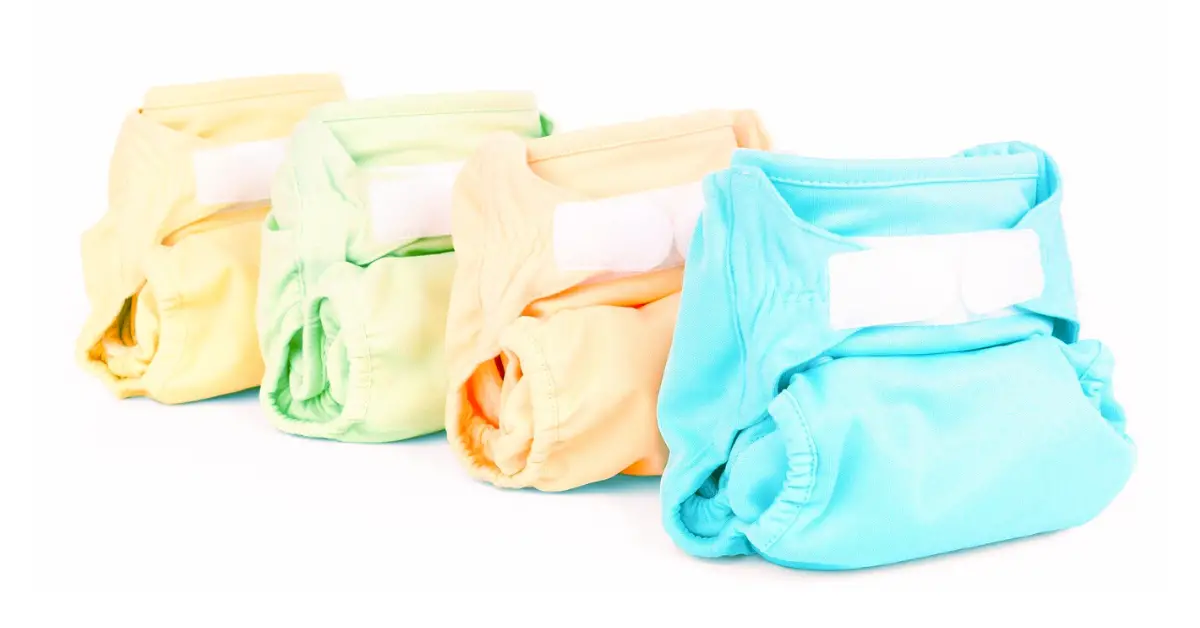
Types Of Cloth Diapers
There are a few types of cloth diapers for parents to choose from. Which one you choose will depend on what exactly your family needs, and the specifics of the diaper itself.
Here are the different types of cloth diapers to consider:
Flats
Flat cloth diapers are the traditional square pieces of single-layer fabric that can be folded up a few ways into a diaper. Flats are very affordable and need to be used with a cover. The issue with flats is the time and effort taken to fold them into a diaper, but for some, the low cost is worth it.
Prefold Diapers
Prefold diapers are rectangular pieces of cotton fabric that have been pre-folded into three different sections, with the middle section being absorbent. This type of cloth diaper is ideal for newborns.
Prefolds are quite versatile, as they can be folded to fit your baby on its own, or they can be folded down to a trifold and used as a liner. Both ways need to be used with a diaper cover.
Fitted Diapers
Fitted diapers do not need to be folded at all, and are ready to be put on your baby as is. They are usually made from cotton, fleece, hemp or bamboo, and are fitted either using snaps or Velcro. While these cloth diapers are wonderfully absorbent, they are not waterproof.
You do not have to do much when it comes to washing and using these diapers, as they can be fitted onto your baby right out of the dryer.
Contoured Diapers
Contoured diapers fit your baby much like fitted diapers do, but they need to be closed using pins or a snappi. You will also need to use a diaper cover for a contour diaper. They are absorbent and easy to use and can be used straight after washing and drying without needing inserts or liners.
Hybrid Diapers
A cross between cloth diapers and disposable diapers, hybrid diapers come with a washable outer cover, and you need a disposable insert, or a washable cloth insert, to capture moisture. These liners or inserts are replaced each time the diaper is dirty, and the covers washed.
Pocket Diapers
Pocket diapers are really easy to use and are considered very convenient. You do not need a diaper cover for pocket diapers, and they can be closed using simple snaps or Velcro.
The diaper has a pocket that needs to be lined with an insert. This could be an insert made from microfiber, cotton, hemp, or bamboo, which absorb liquids, but still help your little one stay dry as the wetness is absorbed into the insert, and doesn’t sit on the liner.
All-In-One Diapers
All-in-one diapers are a popular choice for parents who are after convenience. You do not need covers, inserts, linings, stuffing, or anything, to be able to use these diapers. Just like a disposable, they are all in one piece and ready to be used.
Sleeve Diapers
Sleeve diapers are very similar to pocket diapers, the only difference being that there is an opening on either side of the insert pocket. This means you do not have to pull out the dirty insert when washing, and you can throw the whole diaper into the wash, and the insert will be pulled out of one end of the pocket in the wash.
Diaper Inserts
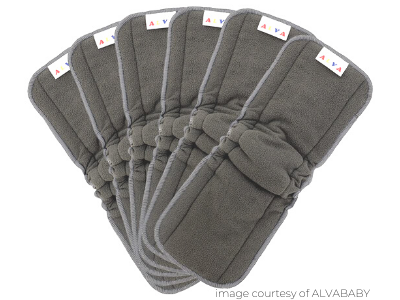
If you decide to use a cloth diaper that requires inserts, you have another decision on your hand! There are different options when it comes to the types of inserts you decide to use, and your decision will be based on a few things, such as affordability, absorbency, and how sensitive your baby’s skin is.
What Are They?
Inserts are an absorbent layer placed into a cloth diaper, usually stuffed into a pocket, or laid into the inside of a diaper cover. These absorb any liquid and wetness from your baby, drawing it away from their skin to help make them feel more comfortable and to avoid diaper rash and irritation.
There are also doublers, which is an extra layer you use to increase the absorbency of the diaper. These are also known as boosters. They can be laid on top of the insert, or stuffed into the pocket along with the insert.
Liners are also needed with cloth diapers. These are laid on top of the pocket or the insert, to keep your baby’s bum dry, and to separate the wet insert from your baby’s bum. These can be disposable or reusable.
What Are The Types Of Inserts?
Inserts come in a few different styles. Which one you choose might depend on the type of cloth diaper you have chosen for your baby.
- Flat inserts are a square of fabric that is folded down into a rectangular shape before being stuffed into the pocket of the diaper.
- Prefold inserts have already been folded and sewn down into the correct shape and can be placed inside a diaper cover.
- A trifold insert is slightly wider than a prefold, and needs to be folded into thirds before being placed into the diaper.
- Pad inserts feature layers of material sewn together to form a thick pad, which is the right shape to be stuffed into a diaper.
- Petal style inserts are two or three inserts that have been sewn together on either end.
- Snake-style inserts are a long strip of absorbent material that you can fold down to fit the diaper.
Which Material Is Best?
Cloth diaper inserts are made in a variety of materials, so you are easily able to pick one that fits your lifestyle and your budget!
Microfiber
Microfiber inserts are the most popular, as they are affordable and effective. They absorb liquid quickly and tend to dry very quickly too. The downsides to microfiber are that it does flatten over time, it does hold on to smells, and as it absorbs liquids so well, it can cause a rash if placed directly against your baby’s skin.
Cotton
Cotton, like microfiber, is an affordable option as an insert. It can be organic, non-organic, and available in many different finishes. Some of the finishes include terry, flannel, or jersey. As cotton is absorbent, it is a good choice for heavy wetters.
You might find that cotton is bulkier than some other options, and it might take longer to absorb liquids than some other options.
Bamboo
While many people consider bamboo to be a natural fiber, it is worth noting that it does need to go through heavy processing to be turned into bamboo rayon, which is what the insert would be made out of.
Bamboo is a step above cotton and microfiber when it comes to price, but they are soft and absorbent, and wicks moisture away from your baby’s skin almost four times as much as cotton. You might find the bamboo insert is blended with cotton.
Hemp
Hemp is the top tier of inserts, and it is the most expensive, but it does have its benefits. Hemp holds more liquid than the other liners, but it also takes a long time to dry. It can feel stiffer than the other liners too.
It is however the most sustainable option, which makes it a top choice for those who want the most sustainable diaper system possible.
Types Of Diaper Liners
Once you have chosen the type of insert you want, you will need to choose between two types of liners.
Biodegradable Liners – Biodegradable liners are single-use liners that are made from soft pieces of fabric. You simply pull the liner out of the diaper and flush it down the toilet.
Reusable Liners – Reusable liners need to be washed after each used. They wick moisture away from your baby’s skin and help to prevent rashes. These liners can be made from fleece or suede, and both make it easy to clean up dirty diapers as well.
How To Change A Cloth Diaper

How you change a cloth diaper will depend on the type of diaper you have chosen, but here is a general guide that will get you started:
- Lay your baby down onto a safe changing space. Lift up their bottom by slowly holding their ankles and lifting upward. Remove the diaper and set it aside somewhere they will not be able to reach.
- Wipe your baby’s bottom down with wet wipes or a wet cloth. Once clean, apply any cream if needed.
- Lift your baby up again gently by the ankles, and slide the clean diaper under their bottom. Make sure that all liners or inserts are placed into the diaper before putting it on. Bring the top of the back of the diaper up to your baby’s waist.
- Bring the top of the front of the diaper to your baby’s belly button, and fasten it closed using whatever method the cloth diaper requires. Place a cover over the diaper if needed, making sure all of the inside of the diaper is tucked in properly.
- Use your fingers to check if the diaper is the right fit. If you can slide one finger into the diaper leg easily, then it is fine. However, if three fingers slide in easily, the diaper needs to be tightened.
- Once your baby is in a safe spot, clean up the dirty diaper by flushing any waste down the toilet, removing any liners and inserts if needed, and placing the diaper in the wash.
How To Wash A Cloth Diaper
Dirty cloth diapers can’t just be thrown into the wash as is, and you will need to follow a bit of a routine when it comes to washing them. Here is how to do it:
Flush Away Solid Waste
The first step is to remove any solid waste from the diaper. Dump, scrape, or spray out any solid waste from the diaper into the toilet before placing the diaper with others to be washed.
Babies who are solely breastfed produce waste that is water-soluble, so you can place the dirty diaper into the wash as-is, with the solids still inside, but most moms prefer to dump it out before anyways.
Diaper sprays can be attached to your toilet to help remove solids from diapers. You could also keep a spray bottle of water next to the toilet to help remove solids as well. There are a few ways to do this!
Put The Dirty Diaper Aside
As you won’t be washing one diaper at a time, you will need to put the dirty diaper aside until it is time to wash a few. You can place these in a bucket, a diaper pail, or a wash basket. It is a good idea to ensure the diaper is wet when placing it in the pail, as this helps remove stains and solids more easily in the wash.
Wash The Cloth Diapers
You will need to wash the diapers every second or third day. Any more than this could lead to mildew growth and stains, which you really do not want.
Try washing up to 18 diapers at a time, but no more than this. The diapers will not be cleaned properly if there are too many in the wash.
To start, run the diapers through a speed wash cycle using cold water and no detergent. This will help rid the diapers of any solids and excess stains. Then, run them through a second cycle on hot or warm, using cloth-diaper-friendly detergent. Some parents add baking soda and lemon juice to the cycle to help remove odors and keep the diapers white. Avoid using fabric softeners and bleach.
Dry The Diapers
It is best to dry the diapers on a washing line out on the sun, but if you cannot do this, you can hang them to dry inside. Make sure to not compromise the elastic of the diapers by hanging them in a way where the weight of the wet diapers doesn’t pull at the elastic.
Some cloth diapers can be dried in a dryer, but this could cause the diapers to wear over time, and could cause damage to buttons, snaps, Velcro, and even waterproof linings.
How Often Do You Change A Cloth Diaper?
There should be no difference in the frequency in which a cloth diaper is changed in comparison to a disposable diaper. Disposable diapers are better at holding more liquid, and for longer, than a cloth diaper, but should still be changed often. Here are some guidelines to follow when it comes to changing your baby’s diaper:
- Change the cloth diaper if your baby has made a poo.
- For newborn babies, change cloth diapers every two hours during the day, and before or after a feed at night.
- For babies under six months old, change diapers every 2 and a half hours, and before or after a night feed.
- Babies older than six months, and toddlers, can have their diapers changed every 3 hours during the day.
- Over 12 months old, your toddler will need around 5 diaper changes throughout the day.
You will know your baby best, and use the above guide, and cues from your little one, to determine how often to change their cloth diaper. You can add a booster to a cloth diaper now and then to make it last a little longer, but these are not always comfortable, so should only be used on occasion.
How Many Cloth Diapers Do You Need?
On average, babies go through around 10 to 12 diapers a day, with toddlers making their way through around 6 to 8. With disposable diapers, this isn’t a problem, as you always have fresh diapers on hand, but with cloth diapers, you need to be prepared.
To keep up with your baby’s needs, and ensure that you do not have to do a load of diaper washing a day, you should try and keep around two or three dozen cloth diapers. You will also need to make sure you have enough liners and inserts for the diapers as well.
This should be enough diapers to ensure you always have fresh cloth diapers ready for your baby, and that you can get away with doing washing every second or third day.
Figuring out how many diapers you’re going to need for your new baby is difficult. To help you, we’ve created a handy diaper calculator.
The Best Cloth Diaper Brands
To help you get started, here are some of the best cloth diaper brands that parents love:
GroVia Hybrid Diapers
GroVia is known for its amazing hybrid diapers, which are incredibly easy to use. The diaper cover is made absorbent with snap-in cloth inserts and liners, making them easy for daily use, sitters, and daycare. You can simply pop the dirty disposable liner in the bin and use the cover if it is still clean.
You will need to purchase inserts and liners separately to the diaper, but GroVia makes it a simple process that many parents find easy to use during the day, with the convenience of disposable diapers, but all the benefits of cloth.
View product details here.
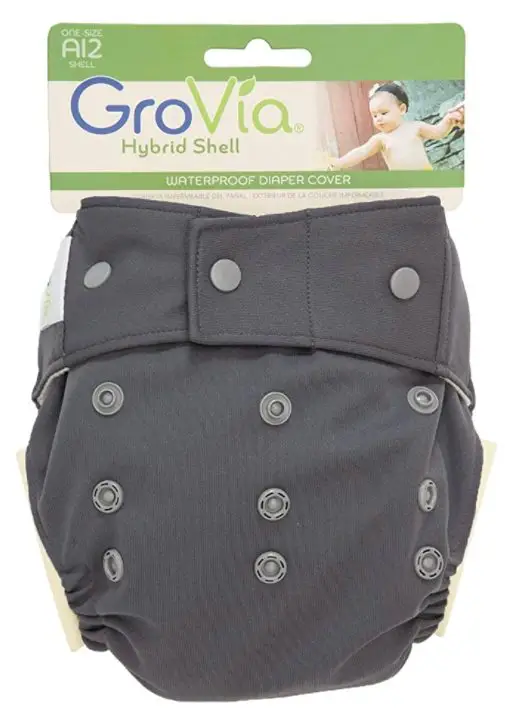
image courtesy of GroVia
Bambino Mio Miosolo All-In-One Diapers
The Bambino Mio Miosolo All-In-One Diapers are incredibly soft diapers that can easily be adjusted using Velcro tabs. They also grow with your baby, allowing you to easily adjust the one-size diaper to fit your baby as they grow.
These are just as easy to use as disposable diapers and are soft and comfortable for babies. They also come in some amazing designs!
To view the latest product pricing click here.

image courtesy of Bambino Mio Misolo
Charlie Banana Reusable Cloth Diapers
Charlie Banana diapers are hybrid diapers, but you can use any liner you want, either disposable, which are held in by a flap, or reusable, which are inserted in a front-loading pocket. The diapers can be readjusted as your baby grows, and remain soft and comfortable throughout.
If you are looking for disposable diaper brand comparisons, please see Huggies vs Pampers: How to Choose the Best Diapers for Your Baby and also our Honest Review of Honest Diapers.
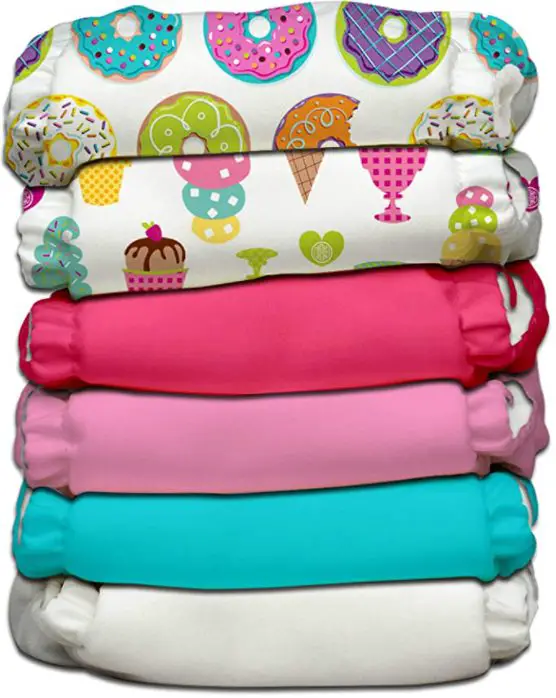
image courtesy of Charlie Banana
The Best Cloth Diaper Organizers
You will need one place to keep your cloth diapers, wipes, inserts, liners, and cream for changing. A cloth diaper organizer does not need to hold all of your supplies, but just enough so you can change your little one without hunting for supplies.
These are some great options for cloth diaper organization:
Baby Diaper Caddy Organizer
This diaper caddy can be carried around easily using the large handles, so you can change your little one anywhere in the house with ease.
The outside of the caddy has smaller pockets for other changing essentials, such as bum cream and cotton wipes.
It offers all-in-one convenience and is large enough to hold enough supplies for a few changes.
View product options here.
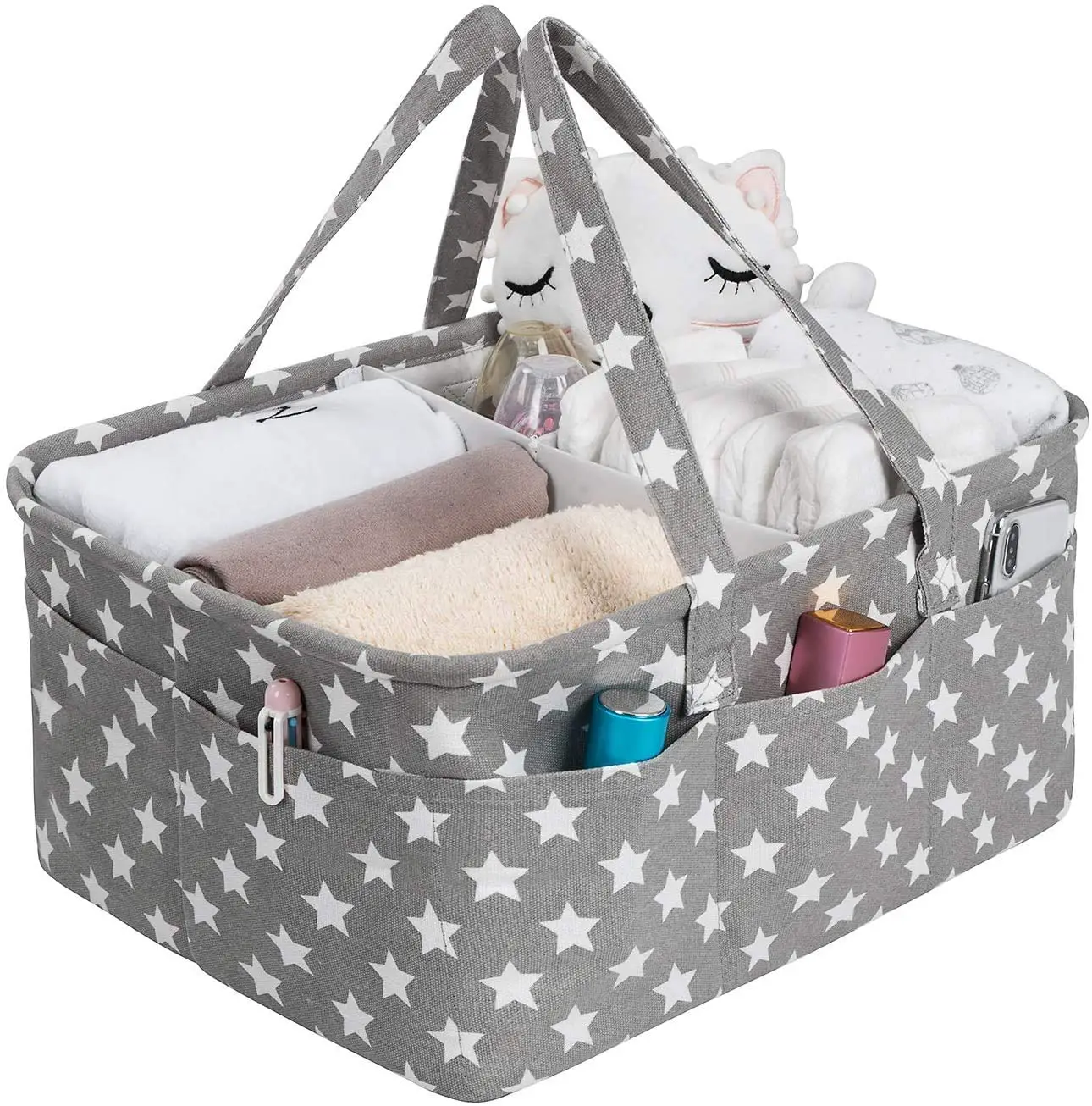
image source: amazon.com
Mila Millie Baby Large Cotton Diaper Caddy
The Mila Millie Cotton Diaper Caddy will go in any nursery and is large enough to hold all of your cloth diaper essentials, while still being wonderfully portable.
It is large enough so that you do not have to fill it daily, with separate compartments to keep your liners, inserts, cloth diapers, cream, and wipes.
Made with high-quality cotton, it is long-lasting and durable, while still being a great piece in any nursery! Click here to view the latest pricing.
For more information, please check out our Best Diaper Bags article.
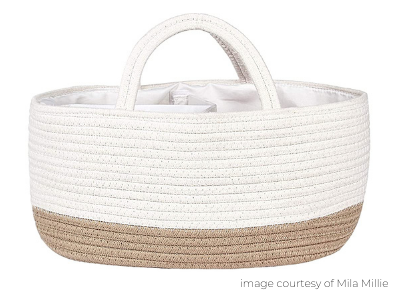
Cloth Diaper Service
For many parents, the idea of having to clean dirty diapers every day or second day is what steers them away from cloth diapers. To fill this need, cloth diaper services have popped up, and they are a saving grace for parents who want to use cloth diapers, but don’t want to do any of the cleaning!
You will first need to see if there is a cloth diaper service in your area and then sign up. Cloth diaper services work by delivering a pail of clean diapers to your door. You use these clean diapers, and store the dirty ones in the pail, which is usually lined to protect against odors.
Once the pail is full, or on a schedule, you leave the diapers outside and a truck drives by and picks them up, leaving a clean pail in its place. These diapers are taken away and washed, and you are given another pail of clean diapers to use.
Most of the diaper services use prefold diapers, or tailored diapers, made from cotton. You will either need to buy your own waterproof cover or some companies lease covers for you to use.
There are different terms and conditions per diaper service, such as you needing to rinse dirty diapers first, or dropping them off somewhere, but this is such a great service for busy parents.
Would cloth diapers make a good diaper cake? Find out everything you need to know about diaper cakes here.
Choosing Cloth Diapers
There are pros and cons for all the types of diapers parents to choose from. Cloth diapers did dip in popularity in the last two decades, as more parents went for the convenience of disposable diapers, but as cloth diapers have modernized and become easier to use, they are quickly becoming a favorite.
If the long-term cost saving of cloth diapers doesn’t win you over, then the environmental friendliness should. There is no reason you shouldn’t try cloth diapers on your little one, there are so many options to choose from, with some being just as easy to use as disposables, but with all the convenience of cloth diapers! They truly are worth every cent you spend at first!
Is your baby a water baby? Check out the Best Swim Diapers. Or, if your baby is sleeping through the night (lucky you!), please see the Best Overnight Diapers.
Related Articles:

Rebecca Brown
Rebecca Brown is a mom to two and writer on all things parenting. She has been focussed on content creation and article writing for the last four years, drawing on the inspiration she gets from her own experience as a mother, and the expansive research the job requires.
When not writing, you can find Rebecca outside with the kids, or hidden away enjoying a good cup of coffee!
